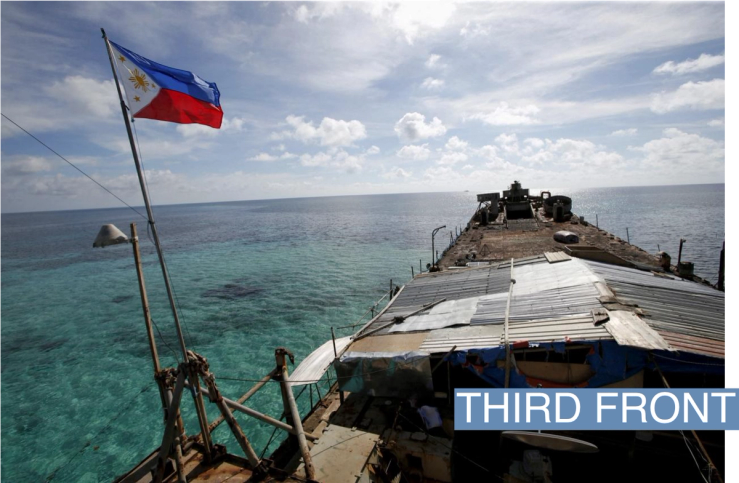The News
China’s growing challenge to the Philippines’ control over a strategic reef in the South China Sea is sparking fears in the Pentagon that Beijing is seeking to exploit the U.S.‘s twin-focus on the Middle East and Ukraine to reshape the Indo-Pacific’s maritime map.
Over the past week, China’s Coast Guard and so-called maritime militia have attempted to block Manila’s navy from resupplying its forces based on the Second Thomas Shoal, a disputed reef 100 miles west of the Philippine island of Palawan. The U.S., which is treaty-bound to defend Philippine territory and military assets, sent American naval vessels to the shoal in recent days, and publicly warned Beijing against trying to take it.
“By conducting dangerous maneuvers that caused collisions with Philippine resupply and Coast Guard ships, the PRC Coast Guard and maritime militia violated international law,” the State Department said Sunday.
But China’s military maneuvers in the South China Sea this month are the just latest in Beijing’s growing threat to the Philippine’s maritime territories and islands, which would play a major logistical role for the U.S. in any conflict with China over Taiwan. In recent months, the Chinese coast guard aimed a military grade laser at a Philippine vessel trying to resupply the Second Thomas Shoal. Beijing’s military also fired water cannons to intimidate Manila’s forces. China appears focused on trying to crack Washington’s alliance structure in the Indo-Pacific, which stretches from South Korea to the island nations in the South Pacific, U.S. officials told Semafor.
The Pentagon, in response, is publicly warning Beijing that the U.S. can manage three geopolitical crises at once. Defense officials have also stressed that the Biden administration hasn’t diminished its focus on Asia. “The United States is a global power. And that means we can deliver effects and execute our deterrence responsibilities across the globe,” Admiral John Aquilino, commander of the U.S.‘s Pacific forces, said last week. “Oh, by the way, the Indo-Pacific Command has two aircraft carriers right now at sea, as well, along with a large portion of the Joint Force, executing deterrence missions in my theater.”
The Philippine military, since the incident, said it’s considering conducting joint resupply missions with its allies to guard against Chinese aggression in the South China Sea. “We are worried, but…the [Philippine military] is willing to defend our territory,” the Armed Forces of the Philippines’ Chief of Staff General Romeo Brawner Jr. told a press conference in Manila on Thursday.
In this article:
Jay’s view
The war in Ukraine has raised questions since last year about whether the U.S. can deter Russia and China at the same time. But Israel’s looming invasion of the Gaza Strip, and the Biden administration’s pledge to help defend Israel against Hamas militants and their backers in Iran, is now raising the specter of Washington having to project power in three theaters concurrently. And this is placing stresses on the Pentagon not seen since the Second World War.
Current and former U.S. officials offered differing views in recent weeks on whether they think Russia, China and Iran are essentially coordinating their military activities to challenge, if not overwhelm, Washington’s influence. Some talk of a Moscow-Beijing-Tehran Axis. But even the less alarmist American strategists say that Washington needs to look at these three antagonists as working in consort.
The three countries have significantly stepped up their defense cooperation and arms transfers to one another over the past year. “How are you going to deal with Ukraine and also with the Middle East and also with the security of the Indo-Pacific region?” Michael Chase, the Pentagon’s deputy assistant secretary of defense for China, asked on Monday at the Atlantic Council think tank. “And the answer is that we have to deal with all of them. And that, in fact, I think that we see growing linkages, and so do our allies and partners.”
Regardless of how much the three countries are coordinating their actions, there’s ample opportunity for each of them to take advantage of the U.S.‘s stretched attention to make geopolitical gains.
The U.S.’s defense strategy in Asia is particularly delicate as it’s based on a network of alliances and partnerships aimed at denying China the ability to control or harass maritime traffic in the world’s most vibrant economic region. Washington’s defenses, in some ways, trace back to World War II in which American and allied military positions on strings of Pacific islands cut off the Imperial Japanese Navy. But China has been aggressively seeking to fracture these island chains through both military and economic coercion.
Most defense planners have fixated on making sure that the U.S. can help Taiwan defend itself from a Chinese invasion. This is particularly the case since the CIA has estimated that Beijing seeks to have the military capabilities for this mission by 2027. But China could also significantly weaken Washington’s Asia defense strategy by seizing something like the Second Thomas Shoal in the South China Sea. This could serve as a warning to other U.S. allies in Asia about the limits of American military power and deterrence.
The View From Beijing
Beijing claims the Second Thomas Shoal, along with the entire Spratly Islands chain in the South China Sea, as part of China’s sovereign territory. (This despite a 2016 international tribunal, which was binding for China and the Philippines, that ruled Beijing had no legal basis to make this claim.) A social media post this week linked to the People’s Liberation Army accused Manila of “seeking trouble” in the disputed waters and “trying to mislead international public opinion.”
China’s Foreign Ministry, meanwhile, warned the U.S. on Thursday to stay out of the dispute. “The U.S. is not party to the South China Sea issue, it has no right to get involved in a problem between China and the Philippines,” spokesperson Mao Ning said at a press conference in Beijing.
Secretary of State Antony Blinken met his counterpart, Wang Yi, in Washington on Thursday. “We have disagreements; we have differences. At the same time, we also share important common interests and we face challenges that we need to respond together,” Wang said before the meeting.
Notable
- The Wall Street Journal this week told the story of a decrepit Philippine naval vessel, the BRP Sierra Madre, that’s central to Manila’s defense of the Second Thomas Shoal.
- The U.S.’s nuclear arsenal can deter China and Russia, a piece in Foreign Affairs argues this month.


